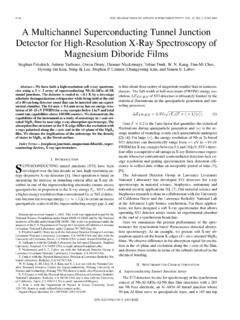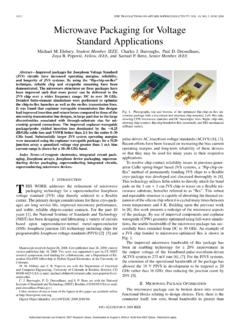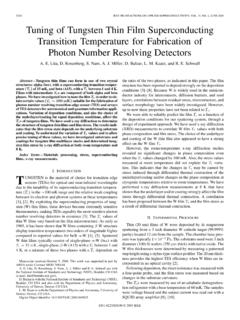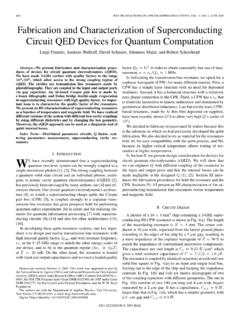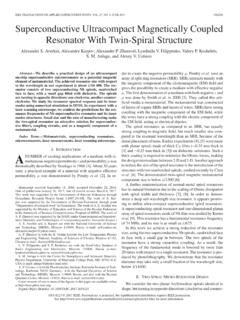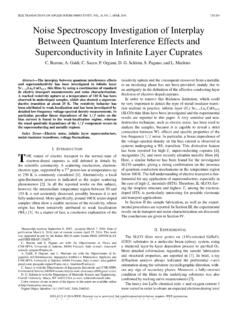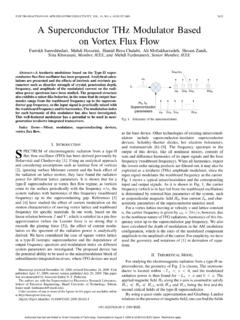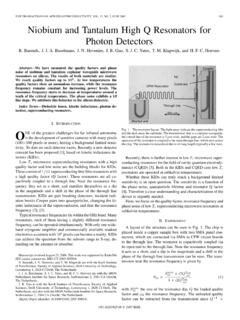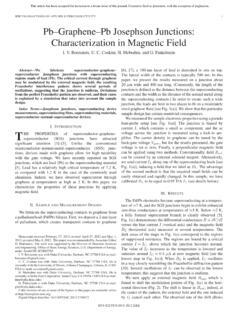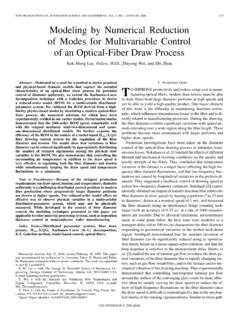Transcription of IEEE TRANSACTIONS ON APPLIED SUPERCONDUCTIVITY, …
1 ieee TRANSACTIONS ON APPLIED superconductivity , VOL. 25, NO. 1, FEBRUARY20151300108 One-Volt Josephson Arbitrary Waveform SynthesizerSamuel P. Benz,Fellow, ieee , Steven B. Waltman,Member, ieee , Anna E. Fox,Paul D. Dresselhaus, Alain R fenacht, Jason M. Underwood, Logan A. Howe,Robert E. Schwall,Senior Member, ieee , and Charles J. Burroughs, A quantum-accurate waveform with an rms outputamplitude of 1 V has been synthesized for the first time. Thisfourfold increase in voltage over previous systems was achievedthrough developments and improvements in bias electronics,pulse-bias techniques, Josephson junction array circuit fabrica-tion, and packaging.
2 A recently described ac-coupled bipolarpulse-bias technique was used to bias a superconducting inte-grated circuit with 25 600 junctions, which are equally dividedinto four series-connected arrays, into the second quantum describe these advancements and present the measured 1 Vspectra for 2 Hz and 10 Hz sine waves that remained quantizedover a mA current range. We also demonstrate a 2 kHzsine wave produced with another bias technique that requires nocompensation current and remains quantized at an rms voltage of128 mV over a 1 mA current range.
3 Increasing the clock frequencyto 19 GHz also allowed us to achieve a maximum rms outputvoltage for a single array of 330 Terms Digital analog conversion, Josephson arrays,quantization, signal synthesis, standards, superconducting de-vice measurements, superconducting integrated circuits, INTRODUCTIONAFTER nearly 19 years since the invention of theJosephson arbitrary waveform synthesizer (JAWS) [1], aquantum-accurate rms output voltage of 1 V has been synthe-sized for the first time.
4 This voltage has been an importantmetrology goal because ac voltage calibrations are commonlyreferenced to primary ac standards (rms detectors such asthermal voltage converters and transfer standards) at a voltageof about 1 V, and most instruments used to measure the acvoltage are most accurate at 1 V [2], [3]. The JAWS systems,which are also called ac Josephson voltage standards (ACJVSs)when synthesizing sine waves and dc voltages, have been usedto calibrate thermal voltage sensors in the 2 mV to 220 mVrms voltage range [4] [7].
5 JAWS and ACJVS circuits are es-sentially perfect digital-to-analog converters whose operationManuscript received July 31, 2014; revised September 2, 2014; acceptedSeptember 8, 2014. Date of publication September 17, 2014; date of currentversion November 26, 2014. This paper was recommended by Associate EditorO. P. Benz, A. E. Fox, P. D. Dresselhaus, A. R fenacht, R. E. Schwall, andC. J. Burroughs, Jr. are with the National Institute of Standards and Technology,Boulder, CO 80305 USA (e-mail: B.)
6 Waltman is with the High Speed Circuit Consultants, Boulder,CO 80302 USA (e-mail: M. Underwood is with the National Institute of Standards and Technology,Gaithersburg, MD 20899 A. Howe is with the University of California San Diego, La Jolla,CA 92093 versions of one or more of the figures in this paper are available onlineat Object Identifier 1. Digitally sampled spectral measurement showing a 120 dBc [deci-bels below the fundamental (carrier)] low-distortion measurement of a 1 V rms2 kHz signal synthesized with all four arrays of the ACJVS chip biased at thesecond quantum state(n=2).)
7 The digitizer settings used were a 1 M inputimpedance, a 10 V input range, a 10 Hz resolution bandwidth, no averaging,and a 500 kilosamples/s (kS/s) sampling rate. Gray data show the digitizer 138 dBc noise floor and the spurious signals with the bias signals turned a quantum state allows them to produce perfect distortion-free waveforms with intrinsically accurate an intrinsically accurate 1 V source has been aparticularly challenging technological goal because quantum-based voltage waveform synthesis requires large and series-connected Josephson junction arrays that are all biased intothe same quantum state with complex bipolar
8 Digital pulsewaveforms clocked at frequencies greater than 10 GHz. Nearlytwo decades of research and development by numerous tech-nologists, metrologists, laboratories, and international researchprograms have been APPLIED to this goal and to turning thedevices into practical systems for calibrating ac voltage stan-dards and other instruments [4] [37]. In addition to enablingsignificant improvements in ac voltage metrology at rms volt-ages of 1 V and below, this system will act as a quantum-based reference for the entire parameter space of the NationalInstitute of Standards and Technology (NIST) s ac voltagecalibrations [38].
9 Stepwise-approximated ac voltage waveformscan be generated by programmable Josephson voltage standardswith a 7 V rms output. However, the nonquantum behaviorof the transitions between the steps prevents these waveformsfrom having intrinsically accurate ac voltages ([13] [15], [37]).The largest rms output voltage achieved to date by a JAWS system is 275 mV, which was produced by summing the voltageof two separately biased Josephson arrays [29]. Recently pre-sented results have doubled the maximum rms output voltagefor a single array to 250 mV.
10 This was done by using a newimplementation of the ac-coupled bipolar bias technique andthe development of new pulse-bias electronics that together1051-8223 2014 ieee . Personal use is permitted, but republication/redistribution requires ieee for more use of this material is permitted. Permission from ieee must be obtained for all other uses, including reprinting/republishing this material for advertising or promotional purposes, creating new collective works for resale or redistribution to servers or lists, or reuse of any copyrighted component of this work in other TRANSACTIONS ON APPLIED superconductivity , VOL.
